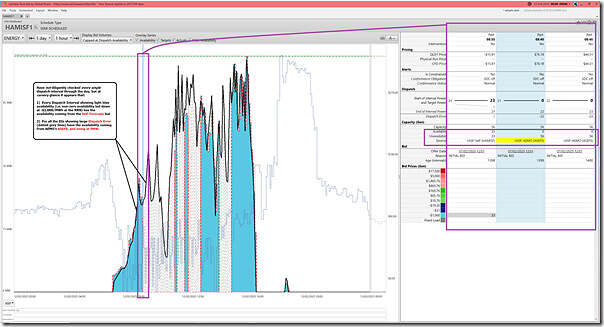And now for something completely different (but perhaps just as cryptic) – here’s a snapshot from the ‘Unit Dashboard’ widget in ez2view focused on the HAMISF1 unit back on Wednesday 12th February 2025 (which is a day that we’ve already written a few things about):
Don’t have time to delve into this, but it is certainly curious as follows:
1) Remember that Linton’s article ‘What inputs and processes determine a semi-scheduled unit’s availability’ is a useful one here:
2) See in the table that:
(a) At 08:35 on that day, the UIGF comes from the self-forecast, which is at 23MW (sun still ramping up for the morning) and everything is hunky-dory
(b) For reasons yet unknown the self-forecast goes away and so UIGF flips back to ASEFS, but AEMO’s forecast says 0MW available for the 08:40 dispatch interval.
(c) No Semi-Dispatch Cap in place, so (following the AER Rule Change) the unit is free to follow the solar resource, which it clearly does
(d) Which means:
i. Because of no SDC in place, then ‘Conformance Status’ would be assessed as ‘Normal’ (i.e. that’s a tick)
ii. But unknown implications in terms of Regulation FCAS Cost Recovery: (currently via ‘Causer Pays’ but moving to Frequency Performance Payments later this year).
3) In the chart on the left we can see that sort of pattern appears to be propagated through the day
So we have a few questions, including:
Q1) What prompts the switch from a self-forecast (which appears to be working) back to ASEFS (which appears to be very much not working on this day)?
Q2) What are the factors at play that are leading to ASEFS consistently setting the availability to 0MW
Q3) What are the implications for FCAS Cost Recovery:
(a) For this unit; but also
(b) For the rest of the fleet.
Q4) … and so on…



Be the first to comment on "A curious case of UIGF for Hamilton Solar Farm on Wednesday 12th February 2025 (Part1)"